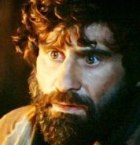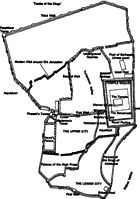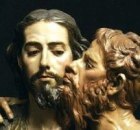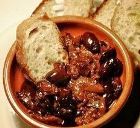What happened at Jesus’ Last Supper?
Questions for Bible study groups
- What was the Passover meal, and why was it important?
- Why was Jerusalem dangerous for Jesus at Passover?
- Why was bread and wine important?
- Describe the scene in the Upper Room.
Ancient Jerusalem at Passover
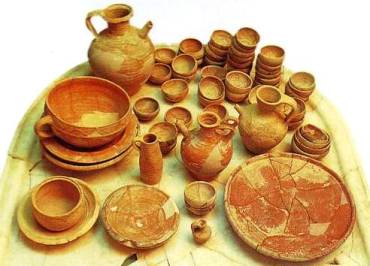
Pottery from ancient Palestine
The time for the Passover celebration has arrived. Jesus is already being hunted by the authorities; he and his disciples know this, but they decide to share this (perhaps last) meal together. At this meal with his friends, Jesus will institute a new type of ceremony, and the covenant he makes with them will be sealed with his blood.
The normal course of a Passover meal was
- an inaugural blessing and prayer followed by the first of four cups of wine and a dish of herbs and sauce
- the story of the institution of the Passover was recited, Psalm 113 was sung, and a second cup drunk
- after a prayer the mail meal of roast lamb with unleavened bread and bitter herbs was eaten, and after a further prayer the third cup of wine was drunk
- Psalms 114-118 were sung, and the fourth cup was drunk.
What actually happened?
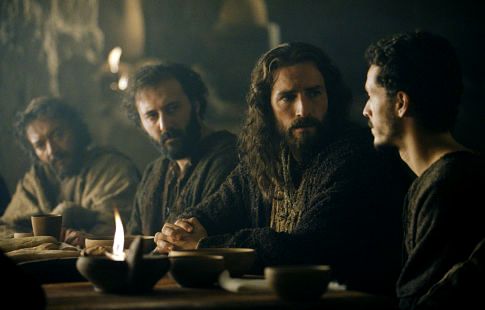
Jesus and his disciples at the Last Supper, from the film the Passion of the Christ
Read the four gospel accounts below, but be aware are you read that they use their narratives not only to report actual historical events but also to interpret the significance of Jesus.
For example, John uses the idea of Jesus’ flesh and blood as food and drink in connection with the discourse after the feeding of the five thousand (John 6). He sees no need to repeat it here.
The other three gospels (Matthew, Mark, Luke) link Jesus’ death to Passover by having both the meal and Jesus’ death on the day of the festival (remember that the Jewish day started at sunset). John does the same thing, but differently: he has Jesus dying on the cross at the same moment that the Passover lambs are being slaughtered in the Temple. The four evangelists are telling the same story, but each in his own way.
What was the setting for this story?
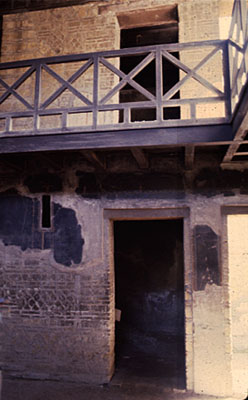
Space was scarce in ancient Jerusalem, so most houses had several stories; an Upper Room was common.
Modern people sit upright when they have a meal, and we might think that Jesus would do the same. Certainly artists like Leonardo da Vinci portrayed the people at the Last Supper in this way.
In fact, Jews at the time of Jesus celebrated a special occasion like the Passover meal reclining on cushions around a low table. People leaned on their left sides, supporting themselves on their left arm and leaving the right arm free. Because he was the host, Jesus would have been slightly in front of the other people at this Last Supper. This is important because it backs up one particular incident in the story: if John had been on his right and leaned back to speak to Jesus, his head would have been close to Jesus’ shoulder; he could have spoken quietly without the other disciples hearing what he said (for this story, see John 13:21-30).
Read the blue text at bottom of this page
Jesus blesses the bread
Why bless the bread?
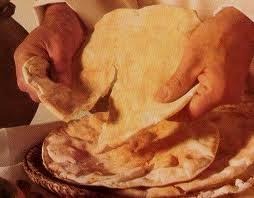 Jesus performed the action of the head of the household at any ordinary Jewish meal.
Jesus performed the action of the head of the household at any ordinary Jewish meal. - He blessed God for providing the bread.
- Then he linked the bread with himself, suggesting that death for him would mean life for others.
Jesus’ words suggest he knew that a violent death, was coming. He knew that, even in the immense crowd that swelled the city of Jerusalem at that time, he would be found and killed.
But his natural terror was balanced by hope, because he believed his death was expiation. He would be the sacrificial lamb that gave its life for many. He would save his people and effect a renewed covenant with God.
Giving his life for others
The idea was not unique to Jesus. Martyrdom for the benefit of Israel is expressed in the Book of Maccabees, written not long before Jesus lived. In 1 Maccabees 6:44 Eleazar, brother of Judas Maccabeus, ‘gave himself for his people’. In 2 Maccabees 7:33, 37-38 there is a gruesome account of the martyrdom of a mother and her seven sons, the youngest of whom says
I, like my brothers, give up body and life for the laws of our fathers, appealing to God to show mercy soon to our nations… and through me and my brothers to bring to an end the wrath of the Almighty which has justly fallen on our whole nation.’
Even today, it is considered a noble thing to give one’s life for one’s country, echoing the idea that the shedding of the blood of the righteous will prompt God to act.
Read the green text at end of page
Jesus blesses the wine
Why bread and wine?
Because they were the essential elements of nourishment for a 1st century Jew. Without them, he/she would not live. By associating himself with bread and wine, even to the point of saying ‘This is my body’ and ‘This is by blood’, Jesus was saying that nourishing the spirit/soul is as necessary as nourishing the body, that we cannot live without spiritual nourishment any more than we can live without food.
But Jesus took it a step further. He identified the bread and wine with himself. His body would die. His spirit would be quenched. But the essence of what he was, of what he had taught and done, would be alive in the bread and wine.
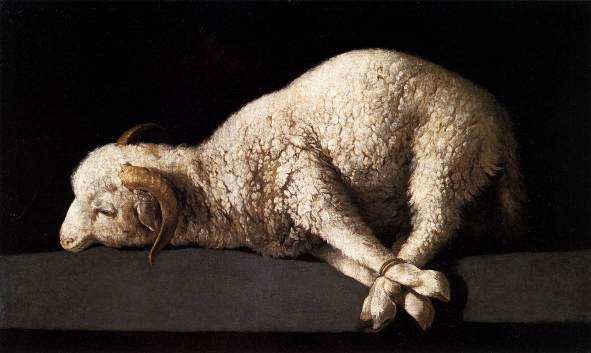
Jesus foresees his own death
Now facing death, Jesus knew that what happened to him would advance God’s purpose, just as the deaths of the Maccabean martyrs atoned for Israel’s sin and paved the way for freedom (however short-lived) for the Jewish nation.
So certain was Jesus of this that he vowed not to drink wine again until he would drink it in the kingdom of God. His blood would be ‘poured out for you’ in the way the blood of a sacrificial animal was poured out over the altar in the great Temple of Jerusalem.
He then saluted his disciples in a special way: he shared his own cup with the assembled group. It was a Jewish custom for the host to share his cup with a particular, honoured guest. But Jesus shared his cup with all the apostles, honouring each one of them.
Read the red text at end of page
Summary
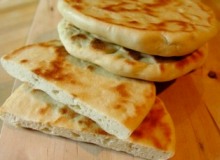 Jesus took basic elements of human sustenance, food and drink, and blessed them. Then he turned the commemoration of this event into a symbolic communion with the redemptive power of his own death.
Jesus took basic elements of human sustenance, food and drink, and blessed them. Then he turned the commemoration of this event into a symbolic communion with the redemptive power of his own death.
To eat these same elements, sharing them with fellow-Christians, is to be joined mysteriously to Christ. For the very first Christians (who were also Jewish), the Lord’s Supper now eclipsed the old Passover. That meal, on that night, gave the Christian church one of its central sacraments.
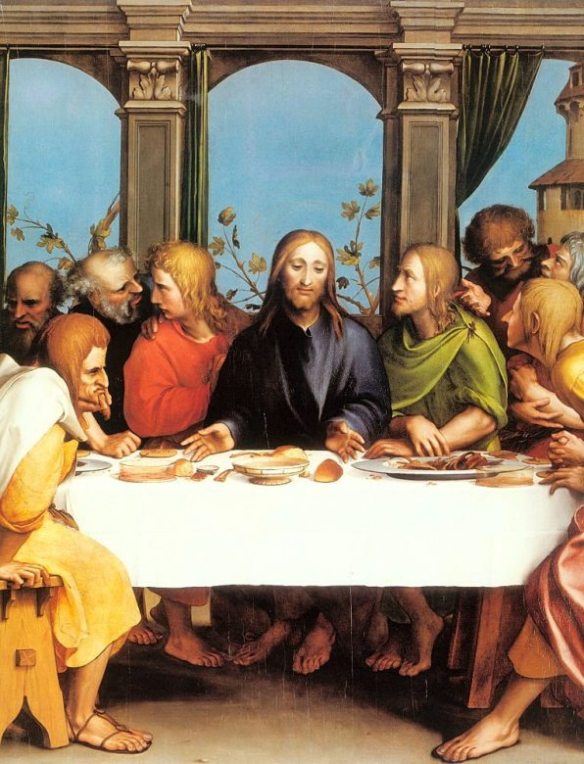
The Last Supper, Hans Holbein the Younger, 1524
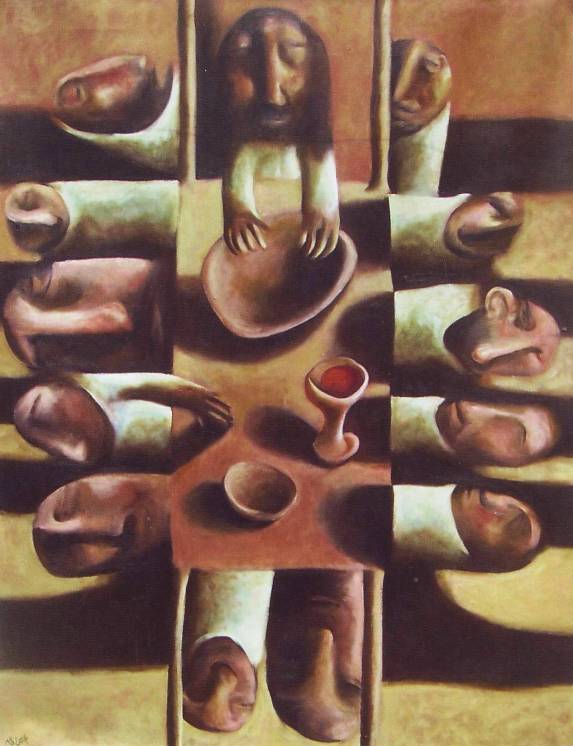
The Last Supper, Nathan Simpson, 2004
Return to top
What the Gospels say
1 Setting the scene: Read the blue text
2 Jesus blesses the bread: Read the green text
3 Jesus blesses the wine: Read the red text
4 John’s brief mention of the bread: Read the black text
Mark 14:17, 22-5
17 And when it was evening he came with the twelve.
22 And when they had taken their places and were eating, he took bread, and blessed and broke it, and gave it to them and said, ‘Take; this is my body.’
23 And he took the cup, and when he had given thanks he gave it to them, and they all drank of it. 24 And he said to them, ‘This is my blood of the covenant, which is poured out for many. 25 Truly I say to you, I shall not drink again the fruit of the vine until the day when I drink it new in the kingdom of God.’
Matthew 26:20, 26-9
20 When it was evening, he sat at table with the twelve disciples.
26 Now as they were eating, Jesus took bread, and blessed and broke it, and gave it to the disciples and said, ‘Take, eat, this is my body.’
27 And he took the cup, and when he had given thanks he gave it to them, saying, ‘Drink of it, all of you; 28 for this is my blood of the covenant, which is poured out for many for the forgiveness of sins. 29 I tell you I shall not drink again this fruit of the vine until the day when I drink it new with you in my Father’s kingdom.’
Luke 22:14-20
14 And when the hour came, he sat at table, and the apostles with him.
15 And he said to them, ‘I have earnestly desired to eat this Passover with you before I suffer; 16 for I tell you I shall not eat it until it is fulfilled in the kingdom of God.’
17 And he took a cup, and when he had given thanks he said, ‘Take this, and divide it among yourselves; 18 for I tell you that from now on I shall not drink the fruit of the vine until the kingdom of God comes.’
19 And he took a loaf of bread, and when he had given thanks he broke it and gave it to them, saying, This is my body which is given for you. Do this in remembrance of me.’
20 And he did the same with the cup after the supper, saying, ‘This cup which is poured out for you is the new covenant in my blood.’
John 13:1-2, 27-9
Now before the feast of Passover … during supper, the devil had already put it into the heart of Judas Iscariot, Simon’s son, to betray him…. Then after the morsel (given to Judas by Jesus), Satan entered him. Jesus said to him, ‘What you are going to do, do quickly.’. . . Some thought that because Judas had the money box, Jesus was telling him, ‘Buy what we need for the feast’
You might like to compare the parallel accounts of the births of Jesus and John the Baptist in Luke’s gospel. You can find the gospel texts at http://www.womeninthebible.net/Elizabeth_bible_text.htm
Notice especially statements about
the pregnancy reaching term, Luke 1.57 and 2.6
the birth statement, Luke 1.57 and 2.7
marvelling onlookers, Luke 1.63 and 2.18
the taking to heart of what had happened, Luke 1.66 and 2.19
circumcision and name-giving, Luke 1.59 and 2.21
John’s birth is clearly a prelude to the birth of Jesus.

